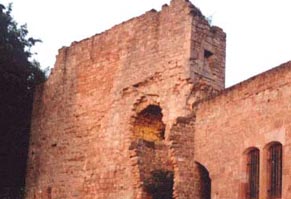
About Nanstein
About Nanstein Landstuhl, a town in Southwestern Germany, has mountains covered with trees surrounding it on all sides except one, which leads through the semi-circle to Oberanbach, Ramstein Air Force Base, Ramstein, Ramstein-Miesenbach, and other small towns. A little farther lies Vogelweh, Vogelweh Air Force Base, and Kaiserslautern. Kaiserslautern is one of the closest cities to Landstuhl. But Landstuhl is not as small as you think. It has a passenger train station, a library and a town hall, several German schools which many children from around the community (including me) attended. One of my former classmates took the train from Kaiserslautern to school each day.
I only remember two mountains, the one that had the Army Base and the Roman ruin on it, and the one with Burg Nanstein and my former house on it. Landstuhl Army Base sat right on a mountain overlooking Landstuhl. On the other mountain was a large and growing neighborhood called die Melkerei. On die Melkerei there was a mixture of German families and American ones who chose to live off the nearby base. Every Halloween I would go trick-or-treating with my friends and family. On almost every block we came to a German house that didn't celebrate Halloween. But that didn't matter. There was also a small community that is considered a sub-division of Landstuhl located near the base of the Melkerei mountain. One of my American friends lived there, my brothers went to kindergarten there, and they had a store where I would sometimes go to buy bread and sweets. German candy and German chocolate are delicious, and unique. The mountains overlooking Landstuhl was hardly mountains. They were just huge hills covered with woods and everlasting trails. My favorite one was the one that led to Burg Nanstein.
Burg Nanstein was a castle, not a very complex one but an important one. Burg means Castle in German. When Landstuhl was a young town, sometime during the 1300's, it was first called Nannenstuhl, then Nanstein, and finally Landstuhl. First came the Celts, then the Romans; which left ruins to remind us of their existence. But it is Ritter Franz von Sicingnon (I didn't spell this right) that is Landstuhl's hero. I cannot relate to you the exact story of his life, but he fought against the many foes during that time of knights of horses. He died on the 7th of May , which also happens to be my birthday. He was buried in the St. Andreas Kirche (church) and fireworks are held on May 7th at Burg Nanstein. In June they have a realistic Mideival festival in June. What could be more realistic than that? Since 1998, I have not visited Landstuhl, so there are most likely 12 new houses in die Melkerei area, 4 new teachers I don't know in my old Grundschule (Grundschule is the word for elementary school. They have a kindergarten, plus grades 1-4.), a whole German vocabulary waiting to be forgotten (mine), and new Italian ice cream flavors in the ice cream cafes downtown to try besides Caramel and Chocolate. Ramstein, which is bigger than Landstuhl and had a bigger (and better) Schwimmbad (a sort of swimming pool center), but is not on the map of Germany hanging on my brother's bedroom door. Neither is Ramstein-Miesenbach and Miesenbach and all those guys. But Kaiserslautern is, and so is Landstuhl, even though it's a tiny dot. That tiny dot makes me feel proud, even though I can't represent the people of Landstuhl if I'm not there. Neither can you. So now you know the whole, long, story of Landstuhl, and what Nanstein is. I hope you enjoyed it. If you didn't, and felt you read this for nothing, then you aren't German, or your'e tired of looking at this page. If so, please click here to go back to my home page, or click here to go to the community of Landstuhl's website! Warning: it's in German.